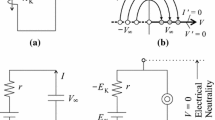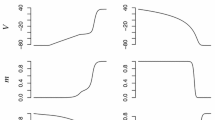Abstract
We present an inversion of the Hodgkin–Huxley formalism to estimate initial conditions and model parameters, including functions of voltage, from the solutions of the underlying ordinary differential equation (ODE) subjected to multiple voltage step stimulations. As such, the procedure constitutes a means to estimate the parameters including functions of voltage of an Hodgkin–Huxley formalism from experimental data.
The basic idea was developed in a previous communication (SIAM J. Appl. Math. 64:1264–1274, 2009). The inversion in question applies to currents exhibiting activation and inactivation, but the version, as published previously, cannot estimate the unknowns for channels that rapidly inactivate just after a brief opening. In such cases, the amplitude of the current, in a given voltage range, is too small to be detectable by the instrumentation using previously applied experimental protocols. This is, for example, the case for the sodium channels in a number of excitable tissue for potential in the vicinity of the cell resting potential. The current communication extends the inversion procedure in a manner to overcome this limitation.
Furthermore, within the inversion framework, we can determine whether the data at the basis of the estimation sufficiently constrains the estimation problem, i.e., whether it is complete. We exploit this element of our method to document a set of stimulation protocols that constitute a complete data set for the purpose of inverting the Hodgkin–Huxley formalism.













Similar content being viewed by others
References
Bassingthwaighte, J. (2012). NSR physiome project. University of Washington. http://www.physiome.org.
Beaumont, J., Roberge, F., & Lemieux, D. (1993a). Estimation of the steady-state characteristics of the Hodgkin–Huxley model from voltage-clamp data. Math. Biosci., 115(2), 145–186.
Beaumont, J., Roberge, F., & Leon, L. (1993b). On the interpretation of voltage-clamp data using the Hodgkin–Huxley Model. Math. Biosci., 115(1), 65–101.
Beaumont, J., Davidenko, N., Davidenko, J. M., & Jalife, J. (1998). Spiral waves in two-dimensional models of ventricular muscle: formation of a stationary core. Biophys. J., 75(1), 1–14.
Bower, J., & Beeman, D., (2012). Genesis. University of Texas and University of Colorado. http://genesis-sim.org/.
Cordeiro, J. M., Mazza, M., Goodrow, R., Ulahannan, N., Antzelevitch, C., & Di Diego, J. M. (2008). Functionally distinct sodium channels in ventricular epicardial and endocardial cells contribute to a greater sensitivity of the epicardium to electrical depression. Am. J. Physiol., Heart Circ. Physiol., 295(1), H154–H162.
Ebihara, L., & Johnson, E. (1980). Fast sodium current in cardiac muscle. A quantitative description. Biophys. J., 32(2), 779–790.
Ermentrout, G. B., Terman, D. H., Ermentrout, G. B., & Terman, D. H. (2010). Interdisciplinary applied mathematics: Vol. 35. The Hodgkin–Huxley equations. New York: Springer.
Grandi, E., Pasqualini, F., & Bers, D. (2010). A novel computational model of the human ventricular action potential and ca transient. J. Mol. Cell. Cardiol., 48, 112–121.
Hines, M., Moore, J., Carnevale, T., Morse, T., & Shepherd, G. N. (2012). Neuron. Yale University. http://www.neuron.yale.edu/neuron.
Hodgkin, A. L., & Huxley, A. F. (1952). A quantitative description of membrane current and its application to conduction an excitable nerve. J. Physiol., 117, 500–544.
Lee, J., Smaill, B., & Smith, N. (2006). Hodgkin–Huxley type ion channel characterization: an improved method of voltage clamp experiment parameter estimation. J. Theor. Biol., 242(1), 123–134.
Loew, L., & Vcell (2012). The virtual cell. University of Connecticut. http://www.nrcam.uchc.edu/about/about_vcell.html.
McCormick, D., Shu, Y., & Yu, Y. (2007). Neurophysiology: Hodgkin and Huxley model—still standing? Nature, 445, E1–E2.
Murphy, L., Renodin, D., Antzelevitch, C., Di Diego, J. M., & Cordeiro, J. M. (2011). Extracellular proton depression of peak and late Na+ current in the canine left ventricle. Am. J. Physiol., Heart Circ. Physiol., 301(3), H936–H944.
Nielsen, P. (2012) Cellml. International collaborative effort. University of Auckland.
Noble, D., Garny, A., & Noble, P. J. (2012). How the Hodgkin–Huxley equations inspired the cardiac physiome project. J. Physiol., 1–30.
O’hara, T., Virág, L., et al. (2011). Simulation of the undiseased human cardiac ventricular action potential: model formulation and experimental validation. PLoS Comput. Biol., 7(5), e1002.
Sobie, E. (2009). Parameter sensitivity analysis in electrophysiological models using multivariable regression. Biophys. J., 96(4), 1264–1274.
Wang, G., & Beaumont, J. (2004). Parameter estimation of the Hodgkin–Huxley gating model: an inversion procedure. SIAM J. Appl. Math., 64(4), 1249–1267.
Willms, A., Baro, D., Harris-Warrick, R., & Guckenheimer, J. (1999). An improved parameter estimation method for Hodgkin–Huxley models. J. Comput. Neurosci., 6, 145–168.
Acknowledgements
NSF grant TG-BCS110013 (to J. Beaumont), SUNY Doctoral Diversity in Science, Technology, Engineering, and Mathematics Fellowship (to A.E. Raba), American Health Assistance Foundation (to J. M. Cordeiro), National Heart, Lung, and Blood Institute Grant HL-47678 (to C. Antzelevitch) and NYSTEM grant # C026424 (to C. Antzelevitch). We are grateful to anonymous reviewer #1 who has thoroughly studied the proof of Lemma 1 and suggested important corrections.
Author information
Authors and Affiliations
Corresponding author
Rights and permissions
About this article
Cite this article
Raba, A.E., Cordeiro, J.M., Antzelevitch, C. et al. Extending the Conditions of Application of an Inversion of the Hodgkin–Huxley Gating Model. Bull Math Biol 75, 752–773 (2013). https://doi.org/10.1007/s11538-013-9832-7
Received:
Accepted:
Published:
Issue Date:
DOI: https://doi.org/10.1007/s11538-013-9832-7




